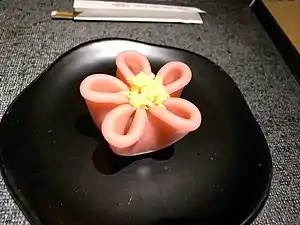Namagashi
Namagashi (生菓子) are a type of wagashi, which is a general term for traditional Japanese sweets and candies.[3] Namagashi may contain fruit jellies, other gelatines such as Kanten, or sweetened bean paste.[4][3] Namagashi is detailed, designed with using seasonal and natural motifs such as leaves and flowers to reflect the various objects of nature in Japan's four seasons.[5] Namagashi are usually freshly made and are much more moist than other wagashi, like higashi.[4][3] It generally contains 30% more water than other types. Like other wagashi, namagashi are made of natural ingredients; additives are rarely used. Namagashi is generally served with tea, and it's traditionally eaten on New Year's for good luck.[2]
 Namagashi in Yokohama, Japan. | |
| Type | Wagashi |
|---|---|
| Place of origin | Japan |
| Main ingredients | Fruit jellies or sweetened bean paste[1] |
| Han namagashi, which is half-cooked and less moist[2] kcal | |
References
- William Shurtleff (1996). Aoyagi, Akiko (ed.). Soy Fiber and Dietary Fiber. Soyfoods Center. p. 45.
- Krystina Castella (2012). A World of Cake. Storey Publishing, LLC. p. 274. ISBN 9781603424462.
- Sosnoski, Daniel, ed. (1996). Introduction to Japanese Culture. Tuttle Publishing. ISBN 9781462911530.
- William Shurtleff (2009). History of Miso, Soybean Jiang (China), Jang (Korea) and Tauco (Indonesia). Soyinfo Center. p. 367. ISBN 9781928914228.
- Helen Saberi (2018). Teatimes: A World Tour. Reaktion Books. ISBN 9781780239682.
This article is issued from Wikipedia. The text is licensed under Creative Commons - Attribution - Sharealike. Additional terms may apply for the media files.